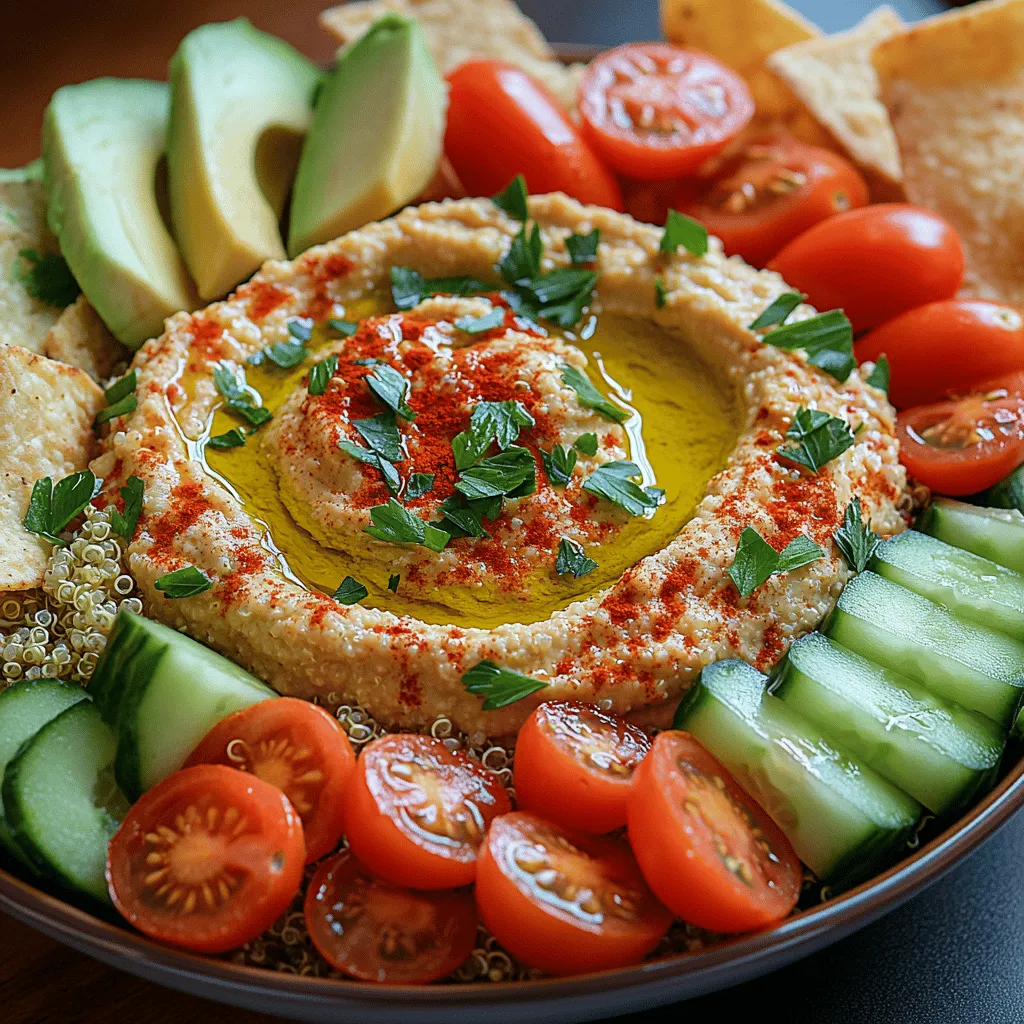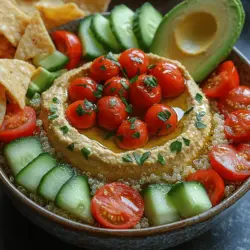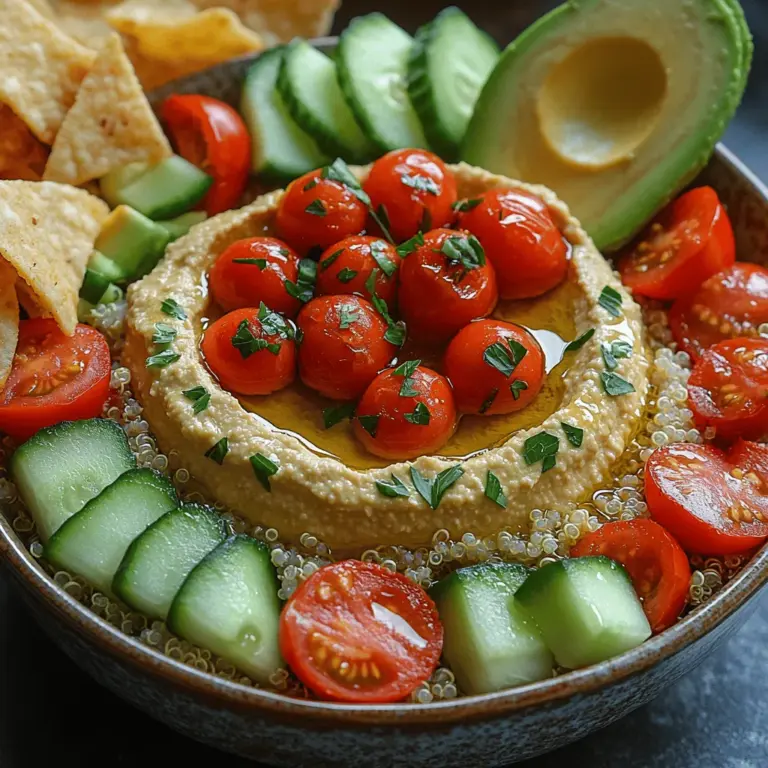Introduction
Hummus has long been celebrated as a versatile and nutritious dish, beloved by many for its creamy texture and rich flavor. This Middle Eastern delight serves as a staple in both casual and formal dining, enjoyed as a dip, spread, or even as a meal centerpiece. In this recipe, we elevate the traditional hummus by introducing the rich, earthy flavor of roasted garlic, creating a harmonious blend that tantalizes the taste buds. Not only does roasted garlic add depth to the hummus, but it also brings a wealth of health benefits, making this dish a wholesome choice for any occasion.
The appeal of roasted garlic hummus bowls lies not only in their flavor but also in their nutrition. By incorporating fresh vegetables and grains, this dish becomes a balanced meal, rich in essential vitamins, minerals, and fiber. Whether you’re looking for a quick lunch, a satisfying dinner, or a dish to impress guests, these hummus bowls are easy to prepare and can be customized to suit various tastes and dietary preferences.
In this article, we will explore the delightful world of roasted garlic hummus, from its origins to its nutritional benefits, and how to create a stunning, healthful dish that’s perfect for any table.
Understanding Hummus and Its Origins
Hummus, a creamy spread made primarily from chickpeas, tahini, olive oil, lemon juice, and garlic, has its roots deep in Middle Eastern cuisine. Its exact origins are often debated, with several countries, including Lebanon, Israel, and Palestine, claiming to have created the first version. Regardless of its birthplace, hummus has become a global phenomenon, embraced by cultures around the world for its delicious flavor and nutritional value.
Chickpeas, the main ingredient in hummus, are a powerhouse of nutrition. They are an excellent source of plant-based protein, making them a popular choice for vegans and vegetarians. High in fiber, chickpeas support digestive health and help maintain stable blood sugar levels. Additionally, they are rich in vitamins and minerals such as iron, magnesium, and folate, further enhancing their appeal as a staple in many diets.
Tahini, made from ground sesame seeds, is another key component of hummus that contributes to its creamy texture and nutty flavor. It is a source of healthy fats and provides a range of nutrients, including calcium and antioxidants. Together, chickpeas and tahini create a nutritious base for numerous dishes, making hummus a beloved item in Mediterranean and Middle Eastern diets.
As a versatile dish, hummus can be enjoyed in a variety of ways. It can serve as a dip for fresh vegetables, a spread on sandwiches, or a topping for grain bowls. Its adaptability has made it a favorite among health-conscious eaters, and it is often featured in meal-prepping routines for its ease of preparation and long shelf life.
The Benefits of Roasted Garlic
Garlic has been revered for centuries not just for its flavor but also for its remarkable health benefits. Rich in antioxidants and antimicrobial properties, garlic is known to support immune function and promote heart health. The active compound allicin, found in raw garlic, contributes to its numerous health-promoting properties. However, when garlic is roasted, its flavor becomes sweeter and mellower, transforming it into a delightful addition to dishes like hummus.
Roasting garlic involves slowly cooking the cloves until they become soft and caramelized, resulting in a rich, buttery texture and a mild, sweet flavor. This process not only enhances the garlic’s taste but also makes it easier to digest, allowing more people to enjoy its health benefits without the pungency associated with raw garlic. Roasted garlic can be used beyond hummus—it’s a fantastic addition to mashed potatoes, pasta dishes, and even salad dressings, enhancing a variety of recipes with its unique flavor profile.
Incorporating roasted garlic into your meals is an easy way to boost flavor and nutrition. The smooth, savory notes it imparts to hummus elevate the dish from simple to extraordinary, making it a standout choice for entertaining or enjoying at home.
Ingredients Breakdown
To create the perfect roasted garlic hummus bowls, it is essential to use high-quality ingredients that enhance flavor and nutrition. Here’s a closer look at each ingredient that makes this dish a wholesome delight:
Chickpeas
Chickpeas are the star of any hummus recipe and play a vital role in its nutritional profile. These legumes are an excellent source of protein, with approximately 15 grams of protein per cup. The high fiber content, around 12 grams per cup, aids in digestion and helps keep you feeling full longer. Additionally, chickpeas are low on the glycemic index, making them a smart choice for those managing blood sugar levels. Their versatility allows them to be used in various forms, including canned, dried, or even roasted for added crunch.
Tahini
This creamy paste made from ground sesame seeds is essential for achieving the rich texture of hummus. Tahini not only adds a nutty flavor but also contributes healthy fats that are beneficial for heart health. It provides a good dose of calcium, which is vital for bone health, and is packed with antioxidants that combat oxidative stress. When selecting tahini, opt for high-quality, minimally processed varieties to ensure you’re getting all the nutrients.
Olive Oil
The quality of olive oil used in hummus can significantly impact the flavor and health benefits of the dish. Extra virgin olive oil is the best choice, as it is rich in monounsaturated fats and antioxidants. This oil is known for its anti-inflammatory properties and has been associated with numerous health benefits, including reduced risk of heart disease. A drizzle of high-quality olive oil not only enhances the flavor of the hummus but also adds a luxurious mouthfeel.
Fresh Vegetables
Fresh vegetables are a delightful addition to roasted garlic hummus bowls. Ingredients like cherry tomatoes, cucumbers, bell peppers, and radishes not only add vibrant colors and textures but also contribute essential vitamins and minerals. For example, tomatoes are rich in lycopene, an antioxidant linked to heart health, while cucumbers provide hydration and are low in calories. Incorporating a variety of vegetables into your hummus bowls adds nutritional value and makes for a visually appealing dish.
Quinoa vs. Brown Rice
When it comes to choosing a grain for your hummus bowl, quinoa and brown rice are two popular options. Quinoa is a complete protein, containing all nine essential amino acids, making it an excellent choice for plant-based diets. It is also gluten-free and high in fiber, which helps support digestive health. On the other hand, brown rice is a whole grain that provides complex carbohydrates and additional nutrients, such as B vitamins and magnesium. While both grains are nutritious, quinoa has the edge in protein content, making it a great companion for hummus.
By carefully selecting these ingredients, you can create a roasted garlic hummus bowl that is not only delicious but also packed with nutritional benefits. In the next sections, we will delve into the step-by-step process of preparing this delightful dish and offer tips for achieving the best results.

Step-by-Step Instructions for Making Roasted Garlic Hummus
Roasting garlic is a simple yet transformative process that elevates the flavor profile of your hummus significantly. To achieve the perfect roasted garlic, begin by preheating your oven to 400°F (200°C). Take a whole bulb of garlic and slice approximately 1/4 inch off the top to expose the cloves. Drizzle the exposed cloves with olive oil, then wrap the bulb tightly in aluminum foil. Place it on a baking sheet to catch any drips and roast in the oven for 30-35 minutes. Once the garlic is soft and fragrant, remove it from the oven and let it cool before squeezing the cloves out of their skins. The result is a sweet, buttery garlic that will add depth to your hummus.
Now that you have your roasted garlic ready, it’s time to make the hummus. In a food processor, combine one can (15 ounces) of drained chickpeas (also known as garbanzo beans), two to three tablespoons of tahini, the roasted garlic cloves (about four to six, depending on your taste), two tablespoons of freshly squeezed lemon juice, and a pinch of salt. Blend the mixture on high until it becomes a smooth paste. If the hummus is too thick, add a tablespoon of cold water at a time until you reach your desired consistency. This step is crucial, as the texture of the hummus can make or break the overall experience.
As you blend, it’s essential to taste and adjust your seasonings. Add more lemon juice for brightness, salt for flavor, or a drizzle of olive oil for richness. Remember, the final product should be balanced and creamy, with the roasted garlic providing a subtle sweetness that complements the chickpeas and tahini. Once you’re satisfied with the flavor and texture, transfer the hummus to a serving bowl and smooth the top with the back of a spoon. Create a swirl in the center, which will serve as a beautiful base for your toppings later.
Assembling the Hummus Bowls
Now for the fun part—assembling your hummus bowls! A well-constructed hummus bowl not only tastes delicious but also looks visually appealing. Start with a base of your choice of grain. Quinoa, brown rice, or couscous are excellent options, offering a hearty foundation for your bowl. Use about 1/2 cup of cooked grains per serving; this portion size ensures that your bowl is filling without overwhelming the other ingredients.
Next, add a generous scoop of your creamy roasted garlic hummus. A dollop of about 1/4 to 1/3 cup is perfect, allowing the flavors of the hummus to shine through while providing a delightful contrast to the grains. Now it’s time to layer in your fresh vegetables. Consider using a colorful mix of chopped cucumbers, cherry tomatoes, shredded carrots, bell peppers, or radishes. Aim for about 1/2 to 1 cup of vegetables per bowl—this not only adds nutrition but also provides a crunch that complements the creamy hummus.
Presentation is key in creating an enticing hummus bowl. Arrange your vegetables in a way that showcases their colors and textures. You might want to place the cucumbers on one side, the tomatoes on the other, and scatter the carrots on top for a vibrant look. Don’t forget to add a sprinkle of fresh herbs like parsley or cilantro to enhance the visual appeal and flavor of your bowl. A drizzle of olive oil and a pinch of paprika or sumac can also elevate your dish’s presentation and taste.
Variations and Customizations
The beauty of hummus bowls lies in their versatility. You can easily customize them based on seasonal vegetables or personal preferences. For a fall-inspired bowl, consider adding roasted butternut squash, sautéed kale, and a sprinkle of pumpkin seeds. In the summer, opt for fresh corn, zucchini, and basil for a refreshing twist.
For toppings, think beyond the usual. Black olives, crumbled feta cheese, or roasted chickpeas can add an extra layer of texture and flavor. If you enjoy a bit of heat, consider adding sliced jalapeños or a drizzle of spicy harissa. You can also mix in some sun-dried tomatoes or artichoke hearts into your hummus for a flavor boost.
When it comes to the grain base, don’t be afraid to try different options. Farro, millet, or even a blend of whole grains can introduce new flavors and textures to your bowl. You can also switch up the dressing by using a tahini-lemon dressing or a zesty vinaigrette to complement the hummus.
Nutritional Information
Hummus bowls are not just delicious; they are also packed with nutrients. A typical serving of roasted garlic hummus (about 1/4 cup) contains approximately:
– Calories: 100
– Protein: 4 grams
– Fat: 5 grams (primarily from olive oil and tahini)
– Carbohydrates: 10 grams
– Dietary Fiber: 2 grams
– Vitamins and Minerals: Rich in vitamins A, C, K, and folate, along with essential minerals like magnesium and potassium.
These bowls are suitable for various dietary needs, including gluten-free and vegan diets. The combination of chickpeas, tahini, and fresh vegetables provides a well-rounded meal that is both satisfying and nutritious.
Serving Suggestions
Roasted garlic hummus bowls are perfect for numerous occasions. They make for an excellent lunch option, offering a quick yet nutritious meal that can be prepped ahead of time. For dinner parties, they serve as a stunning centerpiece that guests can customize according to their tastes. The bowls can also be great for meal prep, allowing you to have healthy meals ready to go throughout the week.
When serving these bowls, consider pairing them with complementary side dishes. A simple green salad dressed with lemon vinaigrette or a warm pita bread can enhance the overall meal experience. For beverages, a light white wine, refreshing iced tea, or even sparkling water with a slice of lemon can beautifully accompany the hummus bowls.
Conclusion
In summary, roasted garlic hummus bowls are a delightful and nutritious meal option that caters to diverse taste preferences and dietary needs. The process of making roasted garlic hummus is straightforward and rewarding, resulting in a creamy dip that is bursting with flavor. Assembling the bowls allows for creativity, encouraging you to layer vibrant ingredients and showcase your culinary style.
Encouraging experimentation with the recipe is essential; don’t hesitate to make it your own by incorporating seasonal ingredients or personal favorites. Cooking is a joyous and creative process, and sharing healthy, homemade meals with family and friends can bring people together. So gather your loved ones, whip up a batch of roasted garlic hummus, and enjoy the communal experience of savoring good food and great company.

